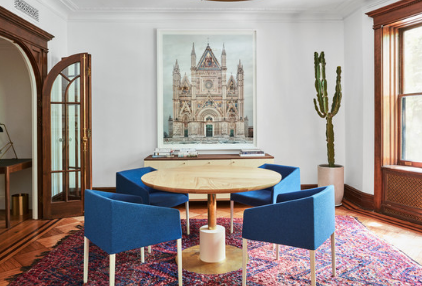Finding a restaurant rug that is both functional and stylish is not an easy task. A fluffy pile of stuff can permanently capture all the crumbs on the table. A carpet that is too small may trip over the chair. But a good rug can bring color, texture, warmth, and style to a restaurant – making that search worth the effort. Read on for 10 tips on choosing the right rug for this hard-working room.

01. Don’t Be Too Big on One Side
There should be at least 24 inches of extra space on either side of the table for restaurant rugs so that guests have enough room to pull out chairs without tripping over the rug. Wider borders are ideal. To make sure you get the correct size rug, measure the dining table, add 24 inches or more on each side, and mark the area directly on the floor with painter’s tape. If the marked area happens to be inside your other dining room furniture (buffet counter, bar cart), consider going bigger.
02. Choose Plain Weave or Short-Haired Carpets
Because spills are inevitable and it’s important that you can easily pull the chairs back, plain weave or short-haired rugs are a practical choice for dining rooms. Place furry rugs, Moroccan rugs, and other thick, fluffy rugs in your living room so they don’t require much cleaning and maintenance.

03. Use Rugs as a Starting Point for Décor
If a rug is the first rug you buy for your restaurant, you or your designer can use it to set the tone of the space and develop a color scheme. Choose the lightest color or background color from the rug for the wall color, and introduce a bolder hue from the rug as an accent for the room, chair cushions, or artwork.
04. Choose Materials That Are Easy to Clean
In general, all-natural fibers such as cotton and wool are the easiest to clean at home, while synthetic blends are the most difficult to clean. The exceptions are scrub-resistant indoor and outdoor carpets and stain-resistant carpets.

05. Feel It Before You Buy a Natural Fibre Rug
Natural fibre rugs, including sisal, jute, and seaweed, are affordable, have a good texture, and have a classic look that has many advantages. However, in places where natural fibers like cotton and wool tend to be easy to clean, these natural materials can be trickier. The key is the texture of the carpet, the finer and smoother it is, the easier it is to clean. On the other hand, it is almost impossible to remove grated food from a carpet of natural fibers with real nodules.
06. The Shape of the Carpet Matches the Shape of the Room
Have a square dining room? Try a square or round rug. Rectangular rooms are made with rectangular carpets. Echoing the shape of the room with a carpet gives the space a pleasant sense of order.

07. The Shape of the Carpet Matches the Shape of the Table
A round dining table goes very well with a round or square rug. Rectangular and oval dining tables go well with rectangular rugs. Square dining tables tend to work best with square rugs, but round rugs can bring a more playful feel.
08. Avoid Light Tones
Unless you’re using your dining room more as a workspace than a dinner party, it’s best to avoid using white and light rugs in this space (although they look pretty). Lighter colors are more likely to reveal dirt and spots than darker, richer colors.

9. Try Carpet Tiles
These interlocking carpet tiles can be configured to any size and shape you need and come in a variety of shades, patterns, and textures. What makes them a smart choice for a restaurant? If a stain seeps into a square, you can replace it without having to buy a whole new rug.
10. Look at a Bigger Space
When choosing colors and patterns for your restaurant rug, think of it as a piece of the larger space puzzle. What are the colors of your dining chairs, dining tables, light fixtures, floors, and walls?If you had an open floor plan, what other rugs would you already use in that space?The rugs you end up choosing should work naturally with these other pieces.





